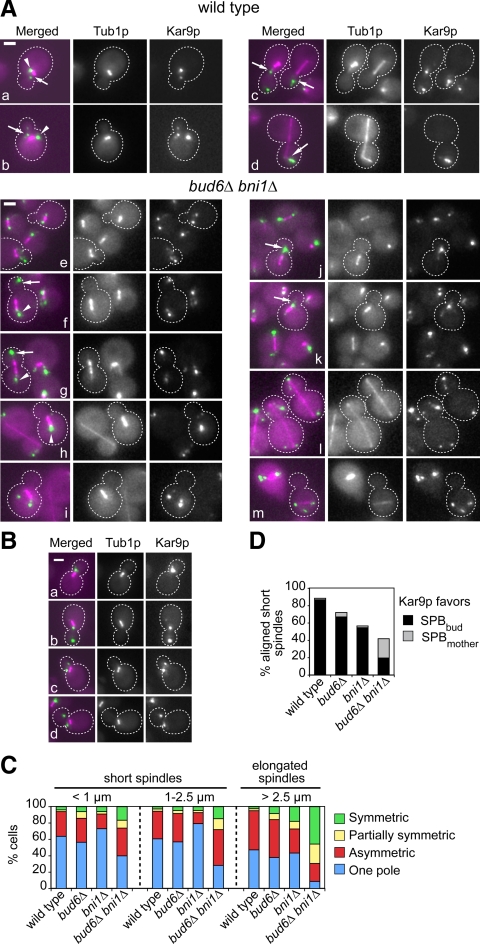Figure 1.
Kar9p polarization to the SPBbud is disrupted in a bud6Δ bni1Δ mutant. (A) Representative images of wild-type (a–d) and bud6Δ bni1Δ cells (e–m) expressing Kar9p-GFP3 (in green) and CFP-Tub1p (in magenta), showing the extent of polarization of Kar9p-GFP3 along the spindle pathway. Wild-type cells exhibited Kar9p-GFP3 label on both poles at onset of spindle assembly (a and b, arrows and arrowheads). Label became polarized to the SPBbud in preanaphase spindles (c, arrows) and continued to favor the SPBbud in anaphase (d, arrow). bud6Δ bni1Δ cells did not coordinate polarization of Kar9p-GFP3 with spindle alignment. (e) Two cells with misaligned spindles marked at both poles by Kar9-GFP3. (f) A cell with a short spindle carrying symmetric Kar9-GFP3 label (arrow and arrowhead) despite spindle alignment. (g) A cell with a correctly aligned spindle and Kar9p-GFP3 label favoring the SPBbud (arrow). (h) Kar9p-GFP3 preferentially marks the SPBmother (arrowhead) despite spindle alignment. (i) Misaligned spindle symmetrically labeled by Kar9-GFP3. (j and k) Kar9p-GFP3 label is associated mainly with the SPBbud (arrows). (l) Two cells with elongated spindle exhibit Kar9p-GFP3 label associated with both poles despite alignment. (m) A cell containing a misaligned anaphase spindle with Kar9p-GFP3 present at both poles. In conclusion, loss of polarity persisted throughout anaphase and seemed unrelated to alignment or SPB identity. (B) Categories of Kar9p localization used in this study: one pole (a), asymmetric (b), partially symmetric (c), and symmetric (d). (C) Distribution of asynchronous cells according to their labeling by Kar9p-GFP3 as depicted in B. Cells with <1-μm-long spindles (n > 282 cells); 1- to 2.5-μm-long spindles (n > 290 cells) or elongated spindles (n > 270 cells) in asynchronous cultures were scored. (D) Distribution of preanaphase cells with correctly aligned spindles according to the relative bias of Kar9p-GFP3 toward the SPBbud or SPBmother, n > 390. The frequency of preanaphase spindle misalignment was 10.7% in wild-type cells, 25% in bud6Δ cells, 40% in bni1Δ cells, and 51.3% in bud6Δ bni1Δ cells. Only in bud6Δ bni1Δ cells Kar9p-GFP3 no longer favored the SPBbud. For a detailed breakdown of all categories scored, see Supplemental Figure S1. Bars, 2 μm.

